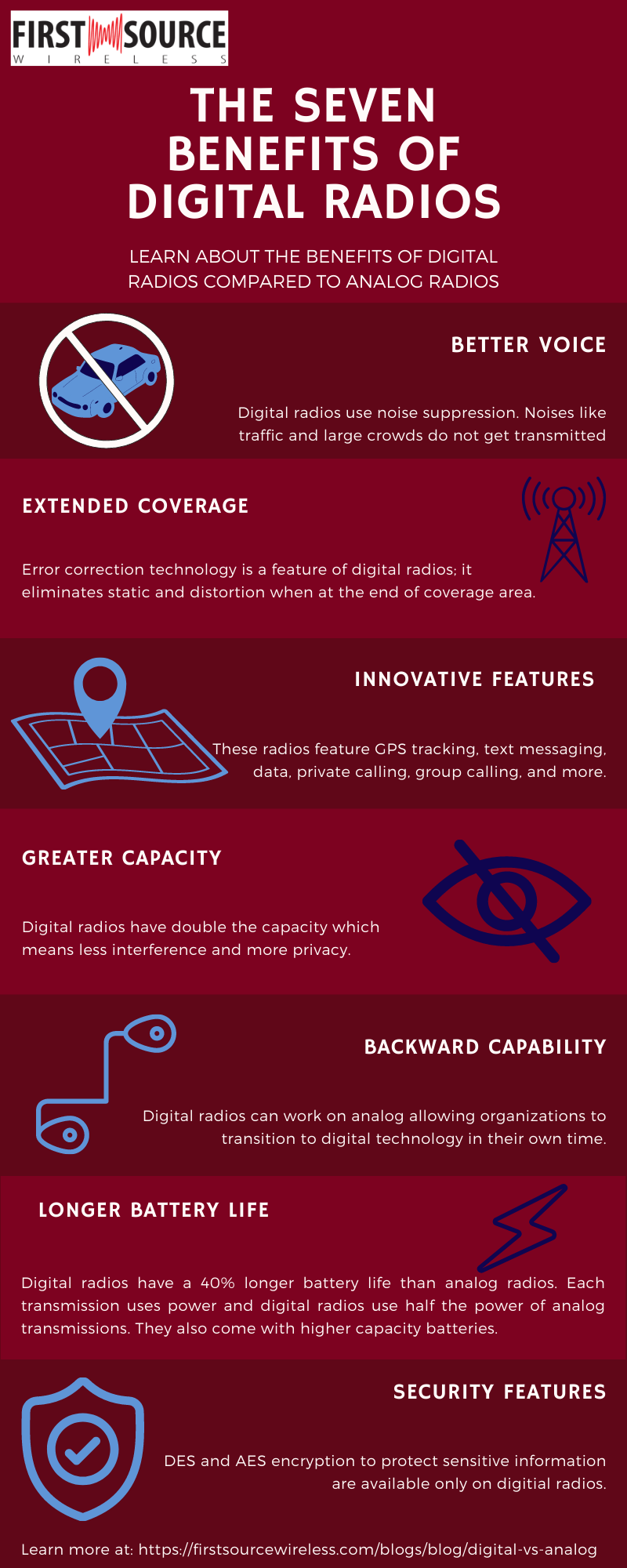Since the beginning, Analog has led the two-way radio market by providing reliable communication to users but today, we’re seeing a shift towards Digital, and for good reason.
Analog has ultimately reached its limits on its capabilities for voice communication while digital is expanding. Analog has been known as the most reliable and easy to use but many agencies and businesses are looking for more from their radio. Whether that’s a clear voice or better functionality, digital is doing just that.
We’re going to talk about the ways Digital radios are outperforming Analog radios. And also cover a few drawbacks that digital radios have that may impact your communication and fleet.
Why Analog is Falling Behind
Organizations are continuing to grow and with that comes the need for more flexibility in their communication. Analog was first introduced as a simple to use device with not a lot of functionality. The voice was often jumbled due to interference and coverage would be limited.
Today, businesses and organizations want more reliability among multiple devices and find the need for better real-time communication. This shows how Analog radios have been falling short and why we’re starting to see a transition to digital radios.
Although digital radios are more expensive than analog radios, the customization and features for large fleets outweigh the cost.
Why Digital is Better
Here are seven ways digital two-way radios are better than analog two-way radios.
- Better voice
- Extended coverage
- Longer battery life
- Greater capacity
- Backward compatibility
- Innovative features
- More Secure
Better Voice
It’s no surprise that users depend on clear communication. Digital has transformed voice for the better. With analog, any interference with a radio signal can result in a distorted static voice making conversation hard to understand. Some digital radios have background noise suppression that doesn’t transmit background noise that may make it hard to understand, like traffic or large crowds.
Extended Coverage
The closer you get to the ends of the radio range the signal drops making the voice static. Other environmental factors such as line of sight, obstacles, and RF interference affect the coverage and voice quality of the radio. While these factors still affect digital radios, these radios have error correction technology that eliminates static, background noise, and distortion when you reach the end of your coverage area.
Longer Battery Life
Digital radios have a 40% longer battery life compared to Analog. Each time a radio transmits, it’s using power from the battery to do so. Each transmission on a digital radio uses half the battery power as it would compare to an analog system. In addition to digital two way radio’s using less power these radio’s typically come with high capacity batteries that utilizes newer chemistries like lithium polymer.
Greater Capacity
You get double the capacity in digital radios as you would in analog. This way you enable communication to more users without interference or losing privacy. Digital radios provide the two 6.25 kHz Channels within a single 12.5 kHz channel enabling extra capacity without the need for extra licenses. You get two calls on a licensed channel while you would only get one on an analog device. It also reduces the need for extra infrastructures such as antennas and repeaters.
Suggested Read: Buying vs Renting a Two-Way Radio
Backward Compatibility
It’s often unrealistic for organizations to transition from their analog radios to digital two-way radios all at once. Most organizations don’t have the time to train and have the funding to move their fleet to fully digital.
Many of today’s digital radios are backward compatible and have a few analog channels that allow digital radios to work with analog. This allows organizations to transition their fleet to digital on their own time, without interruption.
Innovative Features
Digital radio offers GPS tracking, text messaging, data, private calling, and group calls. GPS tracking offers admins to know where a radio user is with location-based services. This is incredibly important during emergencies and knowing where your fleet is at all times. Text messaging, and group and private calls provide users with enhanced communication. In addition to these features newer digital radios can extent coverage with the use of LTE. “When coverage with the traditional radio system is lost. The user’s radio automatically switches over to a Wi-Fi, LTE or other Cellular network to maintain connection”.
More Secure
Digital radios have DES encryption to protect secure information from being heard by anyone. Encryption makes it harder for eavesdroppers to listen in on classified information. On digital radios encryption is possible without disrupting the quality of the audio or range, which happens with Analog systems. Typically, DES and AES encryption is an option when at the time of purchase when customizing your digital two way radio that range in cost between 500-1K depending on the manufacture. Also federal agencies that rely on two way radio communication must adhere to FIPS encryption standards which ensures secure communications when discussing classified information.
Cons of Digital
While Digital does have a lot of advanced features and improvements compared to Analog, there come some drawbacks. One drawback digital users did mention was related to signal. When someone is approaching the end of its signal area, with analog, you would still hear a partial message, while with digital, you don’t hear anything. A lot of times there’s no warning when you’re approaching the end of your RF coverage while in analog your signal would get noisy telling you your close.
Another drawback to Digital is the cost. Digital systems are more expensive than analog systems to build, install, and maintain. A lot of organizations don’t have the funding to fully transition to digital just yet.
Closing Thoughts
Here we’ve covered the pros and cons of digital two-way radios compared to analog. Analog has always been known as simple and easy to use. With digital, you get a better voice, extended coverage, a better battery life, and so much more. While we’re not seeing organizations fully transition to digital radios just yet due to their cost, there is still a need for more functionality that analog radio can’t provide.

First Source Wireless is an authorized dealer of the largest names in communication including 3M, Ops-Core, Pulse Larsen, Cradlepoint, and more. Let us help you improve your team’s communication with the help of two-way radios, headsets, and other products. Contact our team today at 800-991-4569 or shop now.


